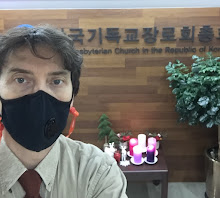I’m still thinking about the events one
hundred years ago in 1919: the March 1 movement for independence and its
aftermath. I am lucky to live close to many places of historical interest, like Seodaemun prison and
Severance hospital, which are full of history right on my doorstep.
 |
| (It was a bad air day - sometimes it happens. I keep my mask ready just in case.) |
 |
| Seodaemun prison - view from the north side |
In 1992 the Seodaemun prison was turned
into a museum, the Seodaemun Prison History Hall, to preserve the history of what took place there during the Japanese
occupation and beyond. I have walked by it often, but I never
really thought much about what took place there, so I decided it was time to
stop in and take a look.
 |
| tower on the west wall |
Soedaemun prison was built in 1908 as Gyeongseong
prison (which was the Japanese name for Seoul). It was built by colonial
Japanese authorities for the purpose of controlling the local population. Originally
designed to hold 500 people, in the years following the peaceful uprising, the
numbers swelled to nearly five times that number, with prisoners housed in
overcrowded conditions.
 |
| interrogation room |
 |
| shackles on display |
Among those who were imprisoned at that
time, one was school-girl Yu Gwan-sun (16), who died in September 1920 from the
torture inflicted on her. According to police records discovered in 2011, of
the 45000 who were arrested by Japanese authorities in relation to the
protests, 7500 died from maltreatment.
 |
photo of Yu Gwan-sun
public domain https://upload.wikimedia.org/wikipedia/commons/1/1a/Yu_Gwan-sun.JPG
|
One of predecessors, Dr. Frank Schofield of
Severance hospital, was an eyewitness to the events. He went around Seoul with
his camera, making a record of the demonstrations to send overseas. As a doctor at Severance, he also ended up
treating many of the casualties. Apparently he
was also able to get access to Seodaemun prison at one point by showing the
business card of the chief of police to the guards. This allowed
him to go in and see the conditions in the prison firsthand.
Here are a few photos that appeared in a
Red Cross pamphlet published in 1920 (probably taken by Schofield).
 |
public domain: Red Cross pamphlet on the March 1st Movement, 1919, p.
42 “Photo of Korean spectators viewing the Korean flag on the Independence
Arch.” http://digitallibrary.usc.edu/cdm/ref/collection/p15799coll126/id/5245
|
 |
public domain: Red Cross pamphlet on the March 1st Movement, 1919, p.
19 “Photo of Japanese policeman taking Korean women to prison.” http://digitallibrary.usc.edu/cdm/ref/collection/p15799coll126/id/5245
|
 |
public domain: Red Cross pamphlet on the March 1st Movement, 1919, p.
17 “Photo of acts of Japanese barbarism.” http://digitallibrary.usc.edu/cdm/ref/collection/p15799coll126/id/5245
|
 |
public domain: Red Cross pamphlet on the March 1st Movement, 1919, p.
18 “Photo of funeral for those massacred in movement.” http://digitallibrary.usc.edu/cdm/ref/collection/p15799coll126/id/5245
|
See also this youtube video on Schofield:
 |
| Independence Gate, located now at Dongnimmun near
Seodaemun Prison, was designed in 1897 to be a symbol of the desire of Koreans for independence. It still plays that role. |


Comments
Post a Comment